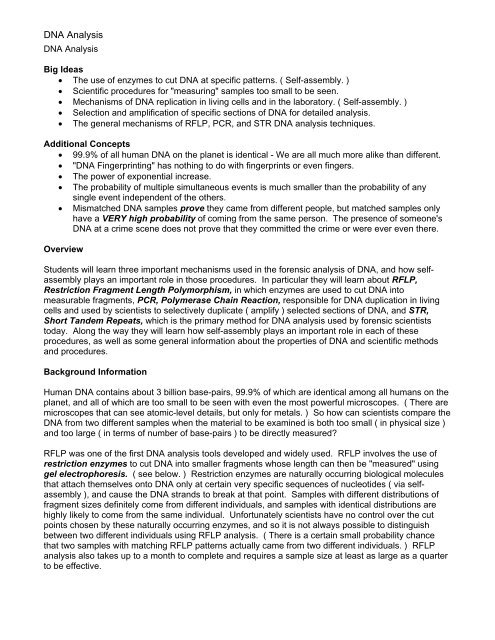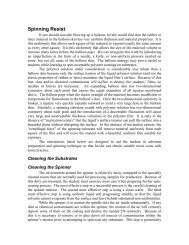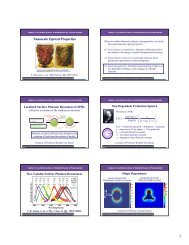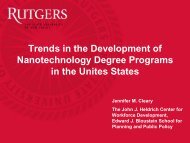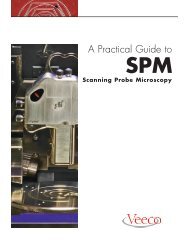DNA Fingerprinting Lesson Plan
DNA Fingerprinting Lesson Plan
DNA Fingerprinting Lesson Plan
Create successful ePaper yourself
Turn your PDF publications into a flip-book with our unique Google optimized e-Paper software.
<strong>DNA</strong> Analysis<br />
<strong>DNA</strong> Analysis<br />
Big Ideas<br />
• The use of enzymes to cut <strong>DNA</strong> at specific patterns. ( Self-assembly. )<br />
• Scientific procedures for "measuring" samples too small to be seen.<br />
• Mechanisms of <strong>DNA</strong> replication in living cells and in the laboratory. ( Self-assembly. )<br />
• Selection and amplification of specific sections of <strong>DNA</strong> for detailed analysis.<br />
• The general mechanisms of RFLP, PCR, and STR <strong>DNA</strong> analysis techniques.<br />
Additional Concepts<br />
• 99.9% of all human <strong>DNA</strong> on the planet is identical - We are all much more alike than different.<br />
• "<strong>DNA</strong> <strong>Fingerprinting</strong>" has nothing to do with fingerprints or even fingers.<br />
• The power of exponential increase.<br />
• The probability of multiple simultaneous events is much smaller than the probability of any<br />
single event independent of the others.<br />
• Mismatched <strong>DNA</strong> samples prove they came from different people, but matched samples only<br />
have a VERY high probability of coming from the same person. The presence of someone's<br />
<strong>DNA</strong> at a crime scene does not prove that they committed the crime or were ever even there.<br />
Overview<br />
Students will learn three important mechanisms used in the forensic analysis of <strong>DNA</strong>, and how selfassembly<br />
plays an important role in those procedures. In particular they will learn about RFLP,<br />
Restriction Fragment Length Polymorphism, in which enzymes are used to cut <strong>DNA</strong> into<br />
measurable fragments, PCR, Polymerase Chain Reaction, responsible for <strong>DNA</strong> duplication in living<br />
cells and used by scientists to selectively duplicate ( amplify ) selected sections of <strong>DNA</strong>, and STR,<br />
Short Tandem Repeats, which is the primary method for <strong>DNA</strong> analysis used by forensic scientists<br />
today. Along the way they will learn how self-assembly plays an important role in each of these<br />
procedures, as well as some general information about the properties of <strong>DNA</strong> and scientific methods<br />
and procedures.<br />
Background Information<br />
Human <strong>DNA</strong> contains about 3 billion base-pairs, 99.9% of which are identical among all humans on the<br />
planet, and all of which are too small to be seen with even the most powerful microscopes. ( There are<br />
microscopes that can see atomic-level details, but only for metals. ) So how can scientists compare the<br />
<strong>DNA</strong> from two different samples when the material to be examined is both too small ( in physical size )<br />
and too large ( in terms of number of base-pairs ) to be directly measured?<br />
RFLP was one of the first <strong>DNA</strong> analysis tools developed and widely used. RFLP involves the use of<br />
restriction enzymes to cut <strong>DNA</strong> into smaller fragments whose length can then be "measured" using<br />
gel electrophoresis. ( see below. ) Restriction enzymes are naturally occurring biological molecules<br />
that attach themselves onto <strong>DNA</strong> only at certain very specific sequences of nucleotides ( via selfassembly<br />
), and cause the <strong>DNA</strong> strands to break at that point. Samples with different distributions of<br />
fragment sizes definitely come from different individuals, and samples with identical distributions are<br />
highly likely to come from the same individual. Unfortunately scientists have no control over the cut<br />
points chosen by these naturally occurring enzymes, and so it is not always possible to distinguish<br />
between two different individuals using RFLP analysis. ( There is a certain small probability chance<br />
that two samples with matching RFLP patterns actually came from two different individuals. ) RFLP<br />
analysis also takes up to a month to complete and requires a sample size at least as large as a quarter<br />
to be effective.
<strong>DNA</strong> Analysis<br />
Gel electrophoresis is a technique that scientists use to "measure" the size of <strong>DNA</strong> fragments. <strong>DNA</strong><br />
samples are first tagged with a dye, and then injected near one edge of an agarose gel. An electric<br />
current is then applied, which pulls the <strong>DNA</strong> material through the gel. Smaller fragments travel farther<br />
through the gel in a given time, which can then be detected thanks to the dye. A reference sample of<br />
known material is always included, to set a scale for the results.<br />
Figure 1 - Typical electrophoresis gel<br />
Whenever a cell replicates itself, all of the contents of the cell must be duplicated, including the <strong>DNA</strong><br />
within the cell. The mechanism by which this happens starts with unwinding and then separating the<br />
two strands of <strong>DNA</strong> from their initial double helix configuration. Each single strand then grows a<br />
complementary mate through a polymerization reaction controlled by the biological chemical<br />
polymerase. This polymerization reaction is termed the polymerase chain reaction, PCR. The<br />
original strand serves as a template to ensure that only a specific matching strand of <strong>DNA</strong> gets created,<br />
in an example of self-assembly.<br />
Within the laboratory scientists can use the polymerase chain reaction in a slightly different form in<br />
order to duplicate ( amplify ) a specifically chosen section of <strong>DNA</strong> for further analysis. First the <strong>DNA</strong> is<br />
heated to completely unwind and separate the two strands. Then primers are added onto the <strong>DNA</strong><br />
strands in specific locations ( using self-assembly ) as starting points for the polymerization. Finally the<br />
polymerase chain reaction is used to grow duplicate strands on each of the two original single strands.<br />
This procedure is then repeated for 20 to 30 cycles, yielding millions to billions of copies through the<br />
power of exponential increase. Careful selection of the original primers limits the duplication process to<br />
only a short specific section of the original <strong>DNA</strong>. PCR can be applied to samples as small as a single<br />
molecule, and even to degraded <strong>DNA</strong> that may have been broken down by time or harsh environments.<br />
Short Tandem Repeats, STRs, are short sections of <strong>DNA</strong> which repeat themselves a certain number<br />
of times. Where the repeat count differs among different individuals, it changes the length of the<br />
encompassing <strong>DNA</strong> fragment, which can be isolated with PCR and analyzed with gel electrophoresis.<br />
STR sections are frequently found within the 98% or so of "junk <strong>DNA</strong>" or "non-coding <strong>DNA</strong>" that does<br />
not contain the codes for any known genetic traits. The probability of two random individuals having<br />
identical STR counts at one particular <strong>DNA</strong> location ( loci ) is relatively large, but the chances of this<br />
happening at thirteen different loci ( the number used in U.S. forensics ) are so vanishingly small as to<br />
be nearly impossible. ( Identical twins, triplets, etc. have identical <strong>DNA</strong>, and the probability of<br />
laboratory error is higher than the statistical probability of random <strong>DNA</strong> matching. )
<strong>DNA</strong> Analysis<br />
Major Learning Goals<br />
1. The student can explain the general mechanism of three important procedures in forensic <strong>DNA</strong><br />
analysis, and explain how self-assembly play a part in each one.<br />
A. RFLP, cutting <strong>DNA</strong> into fragments with restriction enzymes.<br />
B. PCR, selectively amplifying specific sections of <strong>DNA</strong> strands.<br />
C. STR, analyzing fragment length differences due to variable numbers of short tandem<br />
repeats.<br />
2. The student can illustrate how <strong>DNA</strong> replication occurs in both a living cell and in the laboratory,<br />
and can indicate which important steps involve self-assembly.<br />
3. The student can explain how scientists "measure" the size of <strong>DNA</strong> fragments, which are both<br />
too small ( in physical size ) and too large ( in numbers of base pairs ) to examine visually.<br />
Secondary Learning Goals<br />
1. The student understands that 99.9% of human <strong>DNA</strong> on the planet is identical.<br />
2. The student understands the power of exponential growth ( amplification. )<br />
3. The student learns that the chances of multiple events occurring simultaneously are much<br />
smaller than the chances of each event happening independently.<br />
4. The student understands that mismatching <strong>DNA</strong> results prove the samples came from two<br />
different individuals, but that matching results only show an infinitesimally small chance that<br />
they could have come from two different individuals, and that the presence of a suspect's <strong>DNA</strong><br />
at a crime scene does not prove that they committed the crime, or were ever even there.<br />
Activities<br />
Students will be presented with the information described above in a prepared PowerPoint<br />
presentation. In addition, the students will participate in a number of interactive activities centered<br />
about the motivating example of solving a crime mystery:<br />
1. Visual examination of five strings of beads representing five samples of <strong>DNA</strong>. Students should<br />
conclude that this would not be a practical method for analyzing <strong>DNA</strong>.<br />
2. "Cutting" the <strong>DNA</strong> models into fragment lengths, using clothespins representing restriction<br />
enzymes. At this point a visual examination should rule out one of the four suspects but be<br />
unable to distinguish the other four <strong>DNA</strong> samples.<br />
3. Simulating PCR amplification by duplicating a section of the <strong>DNA</strong> bead models into individual<br />
bracelets. First one student makes a duplicate, then two students, then 4, 8, 16, etc to illustrate<br />
the power of exponential growth. Each student gets to take their copy home as a souvenir.<br />
4. Simulating STR analysis by very carefully measuring the lengths of <strong>DNA</strong> sections marked by<br />
clothespins representing primers, and plotting their results on graph paper. Through this<br />
analysis students can rule out all suspects except one, and solve the motivating crime.<br />
References<br />
1. http://en.wikipedia.org/wiki/Genetic_fingerprinting<br />
2. http://en.wikipedia.org/wiki/Dna<br />
3. http://en.wikipedia.org/wiki/Chromosome<br />
4. http://en.wikipedia.org/wiki/Gene<br />
5. http://workbench.concord.org/database/activities/260.html


